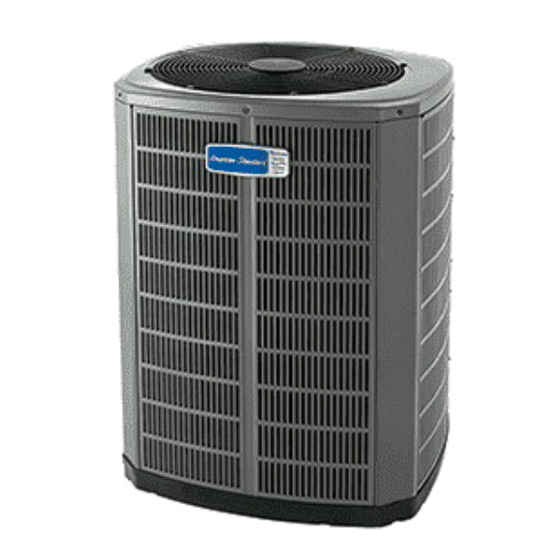
Table of Contents
Advertisement
ALL phases of this installation must comply with NATIONAL, STATE AND LOCAL CODES
IMPORTANT - This Document is customer property and is to remain with this unit. Please return to service informa-
tion pack upon completion of work.
These instructions do not cover all variations in systems or provide for every possible contingency to be met in connection with
the installation. Should further information be desired or should particular problems arise which are not covered sufficiently for the
purchaser's purposes, the matter should be referred to your installing dealer or local distributor.
Note: The manufacturer recommends installing only approved matched indoor and outdoor systems. All of the manufacture's split
systems are AHRI rated only with TXV/EEV indoor systems. Some of the benefits of installing approved matched indoor and out-
door split systems are maximum efficiency, optimum performance and the best overall system reliability.
Table of Contents
Section 1. Safety ..................................................................................... 2
Section 2. Unit Location Considerations ............................................. 3
Section 3. Unit Preparation .................................................................... 5
Section 4. Setting the Unit ..................................................................... 5
Section 5. Refrigerant Line Considerations ......................................... 6
Section 6. Refrigerant Line Routing ..................................................... 7
Section 7. Refrigerant Line Brazing ...................................................... 8
Section 8. Refrigerant Line Leak Check ............................................. 10
Section 9. Evacuation .......................................................................... 11
Section 10. Service Valves .................................................................. 11
Section 11. Electrical - Low Voltage ................................................... 12
Section 12. Electrical - High Voltage .................................................. 15
Section 13. Start Up .............................................................................. 16
Section 14. System Charge Adjustment ............................................. 17
Section 15. Checkout Procedures and Troubleshooting .................. 24
Installer's Guide
Heat Pumps
4A6H4
11-BC38D1-5C-EN
Advertisement
Table of Contents

Summarization of Contents
Section 1. Safety
General Safety Precautions
Covers warnings about electrical components, interpretation of information, and general hazards.
Refrigerant Handling (R-410A)
Details R-410A specific warnings, pressures, oil, and handling procedures.
Electrical Safety
Specific warnings and precautions regarding live electrical components.
Component Specific Cautions
Cautions related to brazing, compressor temperatures, and service valve operation.
Section 2. Unit Location Considerations
Unit Dimensions and Weight
Provides physical specifications and weight for various unit models.
Refrigerant Piping Limits
Outlines maximum total length and vertical change for refrigerant lines.
Suggested Locations for Best Reliability
Recommends optimal placement to ensure proper airflow and minimize noise.
Cold Climate Considerations
Advises on precautions for installations in areas with snow and freezing temperatures.
Section 3. Unit Preparation
Prepare The Unit For Installation
Instructions for checking and removing the unit from its packaging.
Section 4. Setting the Unit
Pad Installation
Guidelines for installing the unit on a proper support pad.
Section 5. Refrigerant Line Considerations
Refrigerant Line and Service Valve Connection Sizes
Details line sizes and service valve connection specifications for different models.
Factory Charge
Information on the factory refrigerant charge and verification methods.
Required Refrigerant Line Length
Guidance on determining and recording refrigerant line length and vertical change.
Refrigerant Line Insulation
Emphasizes the importance of insulating the vapor line.
Reuse Existing Refrigerant Lines
Precautions for using existing refrigerant lines in retrofit applications.
Section 6. Refrigerant Line Routing
Precautions
Steps to prevent noise transmission and ensure proper line routing.
Section 7. Refrigerant Line Brazing
Braze The Refrigerant Lines
Step-by-step instructions for brazing refrigerant lines to service valves.
Section 8. Refrigerant Line Leak Check
Check For Leaks
Procedures for pressurizing lines and checking for leaks using soapy solution.
Section 9. Evacuation
Evacuate the Refrigerant Lines and Indoor Coil
Steps for achieving and verifying proper vacuum levels in the system.
Section 10. Service Valves
Open the Gas Service Valve
Instructions for safely opening the gas service valve.
Open the Liquid Service Valve
Detailed procedure and warnings for opening the liquid service valve.
Section 11. Electrical - Low Voltage
Low Voltage Maximum Wire Length
Table defining maximum wire lengths for low voltage connections.
Low Voltage Hook-up Diagrams
Wiring diagrams for connecting thermostat, air handler, and outdoor unit.
Defrost Control - All Models except 036
Explanation of defrost control operation and settings for most models.
Defrost Control - 036 Model ONLY
Specific details on defrost control operation for the 036 model.
Section 12. Electrical - High Voltage
High Voltage Power Supply
Requirements for the high voltage power supply and compliance.
High Voltage Disconnect Switch
Recommendation for installing a separate disconnect switch.
High Voltage Ground
Guidelines for proper grounding of the outdoor unit.
Section 13. Start Up
System Start Up
Step-by-step guide to safely power up and start the system.
Section 14. System Charge Adjustment
Temperature Measurements
Guidance on measuring outdoor and indoor temperatures for charging.
Subcooling Charging in Cooling (Above 55° F Outdoor Temp.)
Method for adjusting system charge based on subcooling above 55°F.
Subcooling Charging Below 55° F Outdoor Temp. (In Heating Only)
Method for adjusting system charge below 55°F, focusing on heating mode.
Section 15. Checkout Procedures and Troubleshooting
Operational And Checkout Procedures
Checklist for final system inspection and operational verification.
Troubleshooting
Fault diagnosis guide listing system faults and potential causes.















Need help?
Do you have a question about the 4A6H4030N and is the answer not in the manual?
Questions and answers